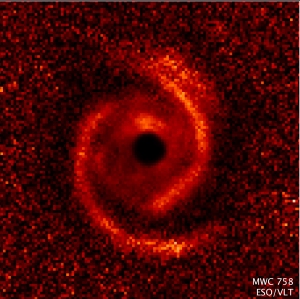
They believe could be evidence for young, massive planets orbiting new stars
Space news (November 23, 2015) –
Astronomers working with ground-based telescopes are proposing massive swirl designs viewed encircling newborn stars could betray the presence of infant planets. Opening the door to a new method of possibly detecting exoplanets orbiting stars and offering a look at the processes forming planets in the cosmos.
The human journey to the beginning of space and time has detected over 1,000 exoplanets around distant stars during the last few years. Detecting infant planets being formed around a nearby, young star enveloped by a circumstellar disk of gas and dust is a different story. Presently, astronomers can’t detect nascent planets embedded inside a vast, pancaked-shaped circumstellar disk.
Those infant planets being formed around young stars could be detected based on the changes they make in the circumstellar disk is a new concept. A new concept based on computer modeling of the birth and evolution of massive disks of dust and gas surrounding young stars. Computer modeling conducted by two NASA Hubble Fellows, Zhaohuan Zhu of Princeton University and Ruobing Dong of Lawrence Berkeley National Laboratory.
“It’s difficult to see suspected planets inside a bright disk surrounding a young star. Based on this study, we are convinced that planets can gravitationally excite structures in the disk. So if you can identify features in a disk and convince yourself those features are created by an underlying planet that you cannot see, this would be a smoking gun of forming planets,” Dong said.
This new planet-finding technique could be significant in the desire to find young, newly-formed planets and understanding the processes the cosmos uses to make them. This approach could be the piece of the puzzle astronomers have been looking for to help unwrap the mystery surrounding the formation of planets. A mystery planetary scientists have been studying in depth for years and one they would love to understand more about.
Computer models show gaps and rings in circumstellar disks could be unseen planets embedded in massive, light-absorbing clouds of gas and dust. Gaps and rings possibly swept clean by the gravity field of a planet or planets, which makes it difficult to determine their number, individual mass, or location.
Astronomers using ground-based telescopes have imaged two massive spiral arms surrounding two newly-formed stars called SAO 205462 and MWC 758. They have also detected similar looking spiral features in nearby stars they’re currently studying to try to gain a better understanding of exactly what’s going on beneath the veil of gas and dust surrounding these distant celestial bodies.
“How they are created has been a big mystery until now. Scientists had a hard time explaining these features,” Dong said. “If the disks were very massive, they would have enough self-gravity to become unstable and set up wave-like patterns. But the disks around SAO 206462 and MWC 758 are probably just a few percent of the central star’s mass and therefore are not gravitationally unstable.“
Additional computer models suggest the dynamics of disks surrounding newly-formed suns are altered by the radiation of a star as it moves through a disk with embedded planets. Computer modeling closely resembling the spiral structures imaged by astronomers points to mutual gravitational fields of newly-formed stars and surrounding disks interacting. This interaction creates regions surrounding newly-formed stars where the density of gas and dust increases until they form spiral waves. Spiral waves that are spread out over these regions by the varying rates of rotation of the disk around the newly-formed star.
“Simulations also suggest that these spiral arms have rich information about the unseen planet, revealing not only its position but also its mass,” Zhu said. “The simulations show that if there were no planet present, the disk would look smooth. To make the grand-scale spiral arms seen in the SAO 206462 and MWC 758 systems, the unseen planet would have to be bulky, at least 10 times the mass of Jupiter, the largest planet in our solar system.“

“There are many theories about how planets form but very little work based on direct observational evidence confirming these theories,” Dong said. “If you see signs of a planet in a disk right now, it tells you when, where, and how planets form.”
Study continues
Astronomers and planetary scientists will now continue their studies of newly-formed star systems and the processes the cosmos uses to create them. They’re planning on using current ground and space-based telescopes to study young star systems. In the years ahead they also use the James Webb Space Telescope to lift the veil of mystery surrounding the birth and evolution of stars in the universe.
Read more about the things astronomers have discovered about the planet-forming region around stars.
Learn more about the regions around young stars.
Learn about the things astronomers have discovered around newly-formed main sequence stars like our Sol.
Learn more about planet formation here.
Discover the James Webb Space Telescope here.
Take a tour of the European Southern Observatory’s Very Large Telescope here.

